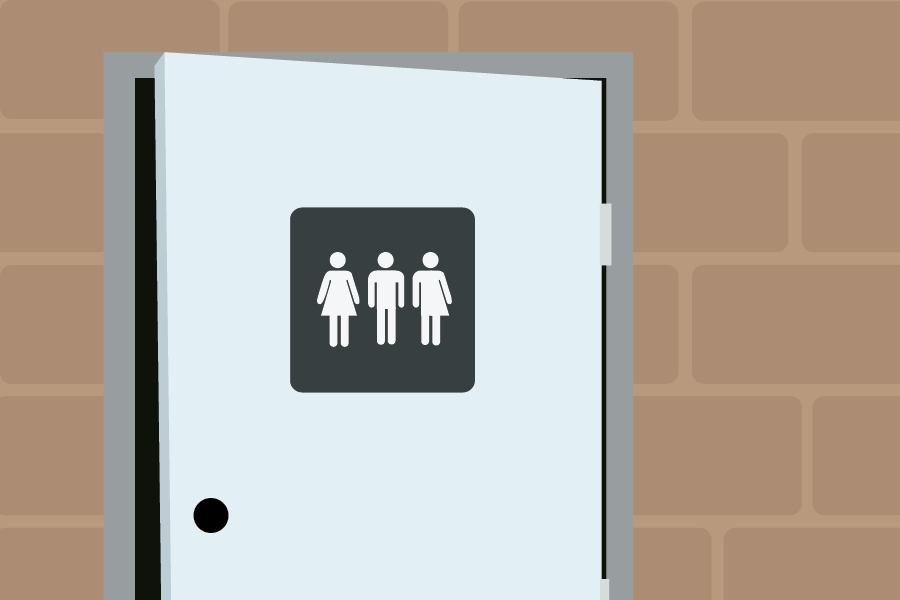
Creating a comfortable environment for all
While waiting outside of an occupied gender-neutral restroom, Iris Bloomfield, a fourth-year English major and transgender woman, was accompanied by another transgender student who looked at her and said, “You too, huh?”
“Sometimes I use the gender-neutral bathroom when I am feeling particularly anxious or self-conscious about my appearance, or if there’s really not any other choice,” Bloomfield said. “Particularly earlier on in my transition, gender-neutral bathrooms were fantastic because […] it affords one a relative amount of safety and less scrutiny in the bathroom. Or we could sidestep the issue all together, at least for me, [with] people not freaking out at my presence in the women’s room.”
Currently, UC Davis appears to have about 160 gender-neutral restrooms located across campus. Bloomfield and Naveen Bhat, a third-year cinema and digital media and theatre and dance double major who identifies as a “queer, brown, non-binary trans person,” both said there are not enough gender-neutral restrooms on campus.
“As someone who doesn’t feel comfortable in gendered bathrooms, [gender-neutral restrooms have] definitely helped me, as well as a lot of other folks I know,” Bhat said. “There are many areas on campus that are nowhere near the vicinity of a gender-neutral bathroom. A lot of these bathrooms are inaccessible, hard to find, out of order and are in remote locations. Ideally, I think that all buildings should have gender neutral bathrooms, whether that means converting gendered restrooms into non-gendered restrooms or creating more restrooms.”
Older buildings, such as Wellman Hall and Olson Hall, hold many classes for all fields of study, yet they lack gender-neutral facilities. However, according to elizabeth coté, director of the Lesbian Gay Bisexual Transgender Queer Intersex Asexual (LGBTQIA) Resource Center, the center will continue to collaborate with campus departments and facilities staff to “continue the expansion of gender-inclusive restrooms” in areas that lack such facilities.
For Bloomfield, the inclusion of gender-neutral restrooms on campus is about “social inclusion” and “not feeling like a second-class citizen.” According to Alison Tam, a fourth-year English major and commissioner of the ASUCD Gender and Sexuality Commission (GASC), gender-neutral restrooms on campus are more than utilitarian.
“It’s not just about having bathrooms that people can get to,” Tam said. “It’s about whether or not students are safe on this campus.”
In addition to increasing the number of gender-neutral restrooms on campus, a recent GASC meeting brainstormed areas of improvement on the UC Davis campus to increase and ensure the safety and inclusion of transgender and non-binary individuals. Ideas included promoting consciousness of intersectionality on campus, publicizing Hate and Bias Reports and respecting and promoting the usage of preferred gender pronouns on forms and Canvas portals.
In 2016, Constance Fuller, a project manager in the Information & Education Technology Project Management Office, started a petition calling for the addition of gender pronouns in the profile pages of students on Canvas. Fuller, a parent in the Davis community, said that she and her child often ruminate on the UC Davis Principles of Community to address situations of discrimination or exclusion at the local schools.
“When I attended a student meeting to present information regarding UC Davis Canvas, […] I observed the student placards not only with their names and roles, but also with their pronouns hand-written,” Fuller said. “Feeling that need from both our current students and our future students, I saw an opportunity to request an update to the Canvas profile that would fill this void in the learning environment. The response from the community, both at UC Davis and amongst other major institutions, was predominantly positive.”
According to Fuller, although the petition received double the votes needed to pass, the request ultimately failed, likely due to “resource limitations.” However, coté said it is important that transgender and non-binary students, in particular, see their identities reflected in aspects of academic life such as Canvas.
In terms of mindfulness regarding the needs of transgender and non-binary individuals on campus, Bhat said administrators do not factor in such needs in the decision-making process.
“Whatever change is happening is the result of long periods of hard work and a lot of labor from student activists,” Bhat said. “It has taken a lot to get the administration to make the tiniest of changes, which says a lot about how much the administration really cares about us.”
Both Bloomfield and Becca Nelson, a third-year psychology and Spanish double major and commissioner in GASC, recounted a transphobic incident that occurred on campus during the Fire Katehi movement that they both felt was particularly telling. While occupying the fifth floor of Mrak Hall, student protesters converted the male and female restrooms into gender-neutral facilities with signs that were subsequently torn down by either administration or faculty members.
“[They tore] down the signs and explicitly [said], ‘I really don’t care about trans people,’” Bloomfield said. “[They] were so upset over the making of these bathrooms gender-neutral [and] completely ignorant of the broader, ideological push for firing Katehi, which included […] more trans-inclusivity and fair treatment on campus.”
For reporting complaints or concerns about faculty or staff members, Tam specifically recommends the Hate and Bias Report. Fortunately, Bloomfield said, she has never reached the point where she felt a Hate and Bias Report would be necessary. However, she also said she has experienced ignorance and feelings of discomfort and annoyance.
“Treat people like human beings, love your neighbor [and] acknowledge the irreconcilable otherness of your neighbor,” Bloomfield said. “I feel like it just comes down to relational ethics — […] respecting difference without erasing difference. Don’t stare at people. It’s really basic, standard ethics.”
Written by: Hannah Holzer – features@theaggie.org




